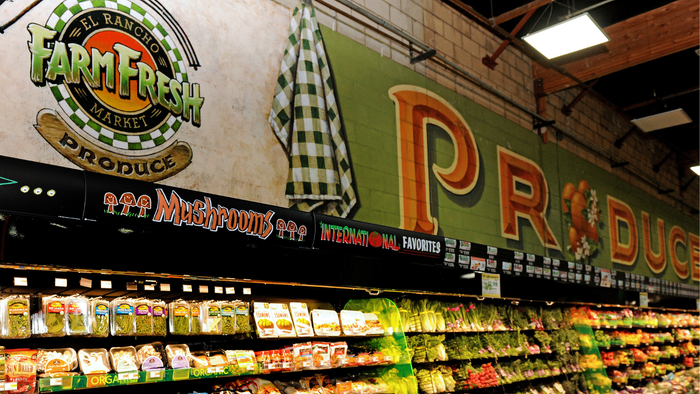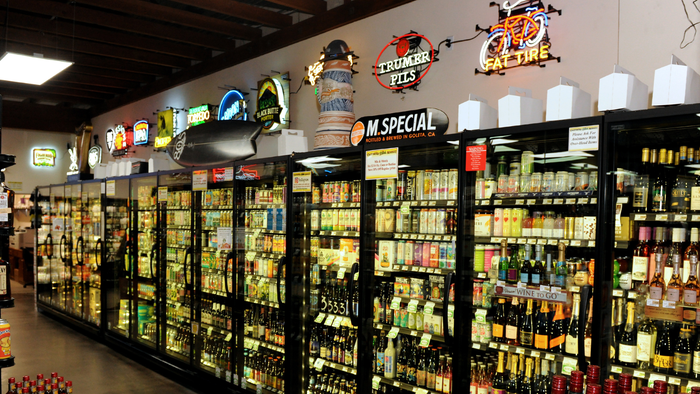April 9, 2024

California’s Central Coast is a foodie paradise, boasting a cornucopia of locally grown produce, locally raised meats and wine from local vineyards. German immigrant Helmut Holzheu recognized the region’s edible and drinkable assets back in 1966, launching a butcher shop and market in Solvang to provide these items to local consumers.
That little store, El Rancho Marketplace, is still thriving today. Now owned by Helmut’s son, Alfred Holzheu, it has expanded and evolved over the years while sticking to its local focus.
In 2012, the company established a sister store in Pismo Beach, named California Fresh Market. There, it offered a broader array of natural, organic and specialty items. A third outpost opened in San Luis Obispo four years later, also under the California Fresh Market banner.
Now serving three very different communities, the co-branded independent strives to meet its shoppers’ needs at each location, both with product selection and personalized customer service. This isn’t always easy, especially amidst today’s increasing competition and labor challenges, but company leaders work hard every day to deliver.
New Hope Network sat down with Jon Price, vice president of operations, to learn what makes El Rancho Marketplace and California Fresh Market so successful after almost 60 years in business.

German immigrant Helmut Holzheu launched El Rancho Marketplace in Solvang, California, nearly 50 years ago to make the region’s abundant produce, wine and meat available to the community.
First, tell me about you. When did you come on board at El Rancho Marketplace and California Fresh Market?
Jon Price: Like a lot of long-term grocery leaders, I started bagging at a young age. I was born and raised on the Air Force base out here, and my first job, at 13, was bagging groceries at the commissary. I kept working there through high school and after. I was a produce manager when I got an offer to come work for El Rancho Marketplace in Solvang under Alfred. I took that job and then just worked my way up through all of the departments, learning the independent side.
Then I stepped away from the company for a few years. I worked for a couple of wholesalers and then for another group of stores down in Ojai. I helped that group grow, then I came back home to this company in 2019.
Now as vice president of operations, do you oversee all three locations?
JP: I oversee all three stores and have a management team below me of general managers, department specialists, an IT manager and other key roles. It’s a robust team, and we’re growing it so that hopefully, eventually, we can get into another store location.
OK, so the original store is still called El Rancho Marketplace. Why was the California Fresh Market banner launched?
JP: It’s a bit complicated. When we opened the Pismo store, we opened it under the El Rancho banner, but it didn’t do well. El Rancho Marketplace had been in the Santa Ynez Valley for 30 years or more by that point, but in Pismo, the name didn’t get recognized or make the impact that we thought it would. So we went through a name-change process.
We’d always had in California Fresh–branded products in our stores—it was a private label for some of the fresh foods we made—so the owners and management team came up with California Fresh Market. Once they changed the name, that was a game-changer for the company. The impact was pretty surprising.
Do the two banners differ in terms of product assortment?
JP: They are very similar. The Pismo location is probably more of the hybrid crossover store than Solvang. At Solvang, we have a lot of meat and potatoes, steak, ranchers, the whole cowboy industry and horse industry out here. It’s also a much smaller store at 28,000 square feet, and we try to fit a lot in.
In Pismo, where we have 34,000 square feet, we’re able to expand a lot more into natural and specialty, and that’s what that area demands. When we went into Pismo, we knew that, so we added a wellness department, which we don’t have in our other locations.
And then some of the other departments are just expanded. We have smaller versions of them in Solvang and SLO, but Pismo is a more open store and we’re able to do bigger cases and displays. It gives us the opportunity to try new things. We usually pilot programs in Pismo, and if they work out, we try to come up with smaller versions for the other stores.

Jon Price, vice president of operations at California Fresh Market, was a produce manager at a commissary on a U.S. Air Force base before he began working at El Rancho Marketplace in Solvang, California. Photo: LinkedIn
How does the San Luis Obispo location fit into that matrix?
JP: SLO is definitely more on the side of Pismo in terms of natural, specialty, wellness, healthy, etc. But our base programs are still very similar to the other stores. We have a big hot-food bar, a self-service wing bar, a great salad bar. You can get your favorite high-end supplements, but you can also get fried chicken.
But there is a lot we’re still learning. SLO is a college town, so the seasonality of the college kids coming in and out, the buying trends and patterns, we’re still figuring all that out, to be honest. We want to support the community when its full and things are happening, but also be a presence when it’s just the everyday customer [in town] and still offer all of the cool things that we do. It’s a tough go, but we’re figuring it out.
One company, three stores, three very different communities to serve—that sounds tricky to navigate!
JP: Yes, it’s a challenge. Plus, we have the normal challenges of being an independent market—that is extremely challenging, especially now. But we pride ourselves in staying in touch with our communities, being highly involved with local organizations and doing things that help drive the business and support the community right around us.
And our customers do tell us if we’re doing something wrong. If we’re missing big categories or new items that they’re buying at the competitors, they tell us, which is nice, and we have the ability to react pretty quickly.
What is each store’s mix of natural and organic versus conventional products?
JP: The produce department in Pismo is heavily organic; the meat departments are pretty similar at all three stores. We carry high-end meat. We’re a Prime-plus store, so we do USDA Prime and American premium Wagyu with Snake River Farms. Our chicken program is heavily Mary’s Organic Chicken.
But overall, Pismo probably runs 60% natural, specialty and organic and 40% conventional. Then it’s the other way around in Solvang: maybe 40% natural and organic and 60% conventional. It’s more right down the middle in SLO.

California Fresh Market's meat counters feature locally raised, grass-fed beef. “We partner with all kinds of local suppliers and startup companies on projects,” says Jon Price, VP of operations.
And you also focus heavily on local products?
JP: Local is huge. Every department has massive pushes for local items, and we partner with all kinds of local suppliers and startup companies on projects. We’re doing one right now with a local retired guy who raises grass-fed cattle. We actually purchase directly from him, so we get this amazing California-raised 100% grass-fed beef to offer our customers. We also have incredible private-label wine programs. We have such a big wine selection at our stores to where we can partner with winemakers on small batches and bottle them under our label.
I could go on and on. We have every local product available on the Central Coast. If you’ve seen it in a specialty boutique store, you can also get it at our stores. So we are very highly focused on local, and that’s something the owners started from the very beginning in Solvang. That tradition will always be part of what we do—which also comes with challenges, right? It’s a lot to manage. That’s why the chains don’t do much of it.
What else distinguishes you from your competitors? What makes your stores special?
JP: I can go on all day about what I feel we do differently. But I think the biggest thing is that when you walk into a competitor chain store, you get long lines, not a lot of full-service counter help and not a lot of engagement. That’s kind of the way things are going right now.
But for us, we try to have a very high-touch customer service–oriented experience. The stores are very busy, and we try to greet our customers when they walk in, ask them what we can help with and show them where to go when they need something. We do our best to have people in the aisles stocking throughout the day so that you can get that customer service—and that comes with challenges. It’s not an easy thing to do right now.
You must have a really great team.
JP: A lot of us are big-time foodies. We’re doing this not only as our careers, but [because] our passion in life is food and wine. We’re in wine country, so a lot of our customers are big foodies too. They are looking for suggestions on meat and the best local produce to buy right now.
We have a lot of hardworking and passionate people who are here to help and support the customers every day. We take a lot pride in being the center of the community. Obviously, everybody has to eat and buy groceries, but we take pride in doing a lot more than just that. We want this to be a food experience as well as a normal grocery experience.

What do you love most about your work?
JP: Well, it has changed over the years. In high school, it was just about making money. But it has definitely transformed into having a passion for food and learning about our industry—where food comes from, how it gets into stores and how people buy it. For me, that was a long education period. It’s so much more than I thought back then. Learning about starting something from nothing, the amount of effort that goes into it, people’s journeys—I am really passionate about all that stuff.
And then I love going to the industry events. I love the community, networking and learning about people’s projects and then turning that into something that we can get on our shelves and help them grow. I can give you 100 examples of big brands out there now that we had on our shelves at the very beginning. It’s really cool to see people whose products you started demoing 10 years ago now getting traction, winning awards and earning amazing accolades from the entire industry.
Correction: Jon Price was misquoted when he said the source of the Pismo store's USDA Prime and American premium Wagyu beer. The source is Snake River Farms. The story was corrected on April 22, 2024.
About the Author(s)
You May Also Like
.png?width=700&auto=webp&quality=80&disable=upscale)




